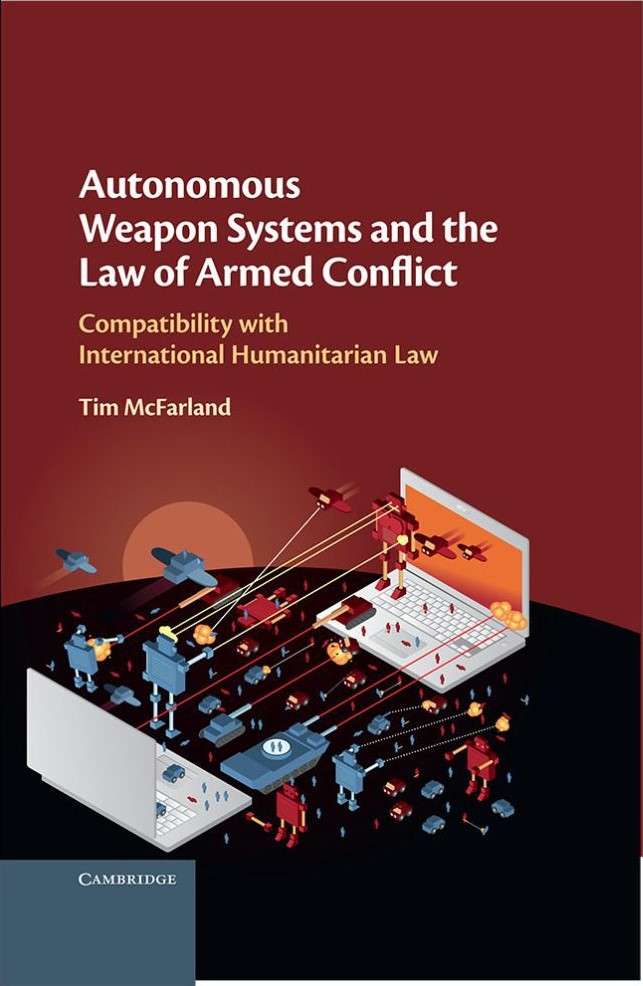Tim Mcfarland, Autonomous Weapon Systems and the Law of Armed Conflict: Compatibility with International Humanitarian Law (Cambridge: Cambridge University Press, July 2020)
Reviewed by Moiz Khan
Autonomous Weapon Systems (AWS) are a rapidly evolving disruptive technology that not only impact the characteristics of warfare but also pose significant challenges for the Law of Armed Conflict (LOAC). The distinctive feature these weapons present is their ability to select and eliminate their targets without human intervention. While these weapon systems have been gaining much consideration amongst Armed Forces of a number of countries, they are also becoming an immediate cause of humanitarian, ethical and legal concern. Hence, there has been an increasing discussion on the need for a comprehensive response against them.
In this context, Dr Tim Mcfarland, who has a diverse background in information technology and law, provides a comprehensive analysis of the legal and ethical issues raised by these systems in his book Autonomous Weapon Systems and the Law of Armed Conflict: Compatibility with International Humanitarian Law, primarily based on his doctoral thesisand previous research. The book examines the implications of the AWS under International Humanitarian Law (IHL); and addresses several questions regarding their definition, characteristics, compliance with ethical norms of humanity in warfare and principle of proportionality, alongside determining responsibility and accountability of such machine systems.
Consisting of eight chapters, the book presents a lucid exposition of the fundamentals behind autonomous systems and examines ongoing research in addition to presently employed technologies. The writer takes a practical stance when defining the AWS as ‘weapons that can select and engage targets without human intervention’ and distinguishes them from automated and semi-autonomous weapons. While identifying four levels of autonomy: human-in-the-loop, human-on-the-loop, human-out-of-the-loop, and full autonomy, the book focuses on the latter two categories, which pose challenges for IHL compliance. Without taking a stance for or against autonomous weapons, the book assesses their compatibility with the existing IHL regime and offers some recommendations for future regulation.
Mcfarland argues that IHL treaties do not specifically regulate the usage of AWS in warfare. Nevertheless, adhering to IHL principles remains essential for employing such systems appropriately. The key legal concerns arising from use of AW systems are scrutinised by analysing concepts like the applicability of the principle of humanity, precautionary principle and Martens’ Clause – that provide safeguarding measures for individuals involved in armed conflicts where there are no explicitly relevant provisions outlined within IHL. The author also discusses challenges of applying weapons’ law and targeting law to the AWS, such as legality of the AWS, proportionality assessment, distinction between combatants and civilians, as well as upholding protection measures for individuals and facilities that are safeguarded by regulations.
The book concludes with some recommendations for future regulation of the AWS, which entail imposing a moratorium on their development and use until suitable legal frameworks are enacted. This may involve creating a new treaty or protocol to proscribe or limit the AWS utilisation or adopting various measures or codes of conduct to guide states and other actors. The author additionally proposes various technical steps that could enhance adherence of the AWS with IHL, including setting up mechanisms for human oversight and integrating ethical algorithms alongside self-destruct capabilities.
Though Mcfarland has extensively dealt with the AWS’ legal issues, there are some notable limitations of the book. Its scope is limited as it traces the compatibility of AW systems with existing IHL, specifically the First Additional Protocol to the 1949 Geneva Conventions. The implications of such systems are broad and extend beyond the scope of IHL, for example, operational effectiveness, strategies, politics and arms control aspects. The book has also not provided diverse perspectives from different stakeholders, such as military strategists, policymakers, and representatives from non-governmental organisations (NGOs) for a more comprehensive and balanced analysis. It also falls short in providing practical guidance for policymakers and practitioners on operational challenges, as well as potential policy recommendations.
However, despite its limited scope, the book is a significant addition to the body of knowledge concerning the AWS and IHL through its clear legal examination based on a widespread comprehension of technological actualities, additionally proposing pragmatic and feasible resolutions. Mcfarland adopts a composed and nuanced methodology to deal with legal and ethical questions raised by the AWS, avoiding simplistic or dogmatic positions.
The book’s strength lies in its timely response to the escalating development of Autonomous Weapon Systems (AWS) for use in armed conflicts. McFarland’s approach, which thoughtfully discusses the AWS in the context of International Humanitarian Law (IHL), is particularly commendable considering the profound implications of these systems’ means and methods on the battlefield. This comprehensive analysis makes it an essential resource not only for lawyers and scholars but also for military officials, civil society members, and students eager to understand the legal dimensions of AWS. The book skilfully bridges the gap between complex legal concepts and the practical realities of modern warfare, rendering it invaluable for a diverse audience interested in the intersection of technology, law, and military strategy.
Moiz Khan is a Research Assistant at the Centre for Aerospace & Security Studies (CASS), Islamabad, Pakistan.




